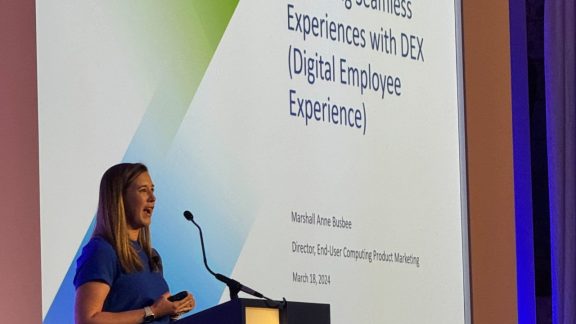You’ve heard it once and you’ll hear it again – these are extraordinary times. Most of us have been uprooted from our normal routines, transitioning from our standard offices to working remote. This is why it’s critical now more than ever before that organizations empower employees to be successful and engaged anytime, anywhere. During the Employee Experience Summit in early April, we addressed how HR and IT teams can achieve business continuity through cross-functional partnerships and why it’s never too late to invest in a remote-first culture. Let’s reflect on the top highlights from the event and how we can impact transformational change in our organizations today.
Close the Digital Workspace Gap
From onboarding to offboarding, it’s crucial that organizations provide the right tools at the right time for employees to contribute effectively. During the Employee Experience Summit, Shankar Iyer, SVP and GM, VMware End-User Computing asked us to rethink the traditional paradigms about what constitutes a workspace. Remote work is now the norm for much of the workforce, and employee engagement is more important than ever. Today, you likely will have a diverse distributed workforce including gig and contract workers, all requiring Day 0 support. Not only is IT having to make decisions around enabling BYOD to device proliferation and provisioning and management of company-owned devices, the End User technology landscape of productivity apps is endless.
Maintaining security and compliance, scaling infrastructure, modernizing IT and managing the heterogenous and often siloed apps all while empowering Employee Experience means that there is a ‘digital workspace gap’. Now that organizations are also tasked with business continuity, the difficult undertaking of managing the balance between seamless employee productivity without compromising on security hasn’t gotten any easier.
So, how can we unify apps, devices and tools to maintain business continuity and accomplish business goals? Workspace ONE is the complete modern digital workspace platform that delivers IT modernization, Zero Trust Security, Modern Management and employee engagement. Establishing a digital workspace that focuses on Employee Experience and enabling productivity can move the needle when it comes to making the transition to remote work as smooth as possible.
Human-to-Human Communication
Outside of technology, there are a number of things leaders can do to assist their workforce in this transition to remote work. The first is to create a level of certainty. As Laurel Farrer, CEO of remote work consulting firm Distribute Consulting shared, over-communication is impossible when managing a remote workforce and especially so in times of uncertainty. Employees are experiencing physical work characteristics that differ from the normal therefore leaders must be empathetic and understanding as employees grow accustomed to these changes. HR and IT leads can facilitate a positive work culture where people can connect on a human-to-human level with flexible policies that promote productivity.
Aside from the need for more structured remote work policies, employees are also faced with balancing their work life with their personal life as they turn their kitchen tables into a virtual office. Many working parents are finding themselves in a position where background noise is inevitable as children are also at home due to school closures and pets wander around the house. Finally, employees who may not be used to remote work are having to familiarize themselves with virtual connectivity tools. By not knowing what tools and resources are at their disposal, it can be difficult for your workforce to be engaged.
As you continue to navigate the situation, it’s important to be cognizant of the fact that most teams aren’t accustomed to working remote. To engage with your new remote workforce, leverage web collaboration tools to stay connected. With that, understand that it will take time to shift your employees’ mindset (let’s face it – not all of your workforce will be so willing to adopt new technology that they aren’t used to working with). Being empathetic towards each employees’ situation – whether it’s regarding the technological learning curve or working from home with new “coworkers” – will go a long way.
Remote-First in the Real World
At VMware, we strive to be strategic partners that help our customers provide a remote-first culture to their employees. Part of this is understanding that a remote-first culture might look different across organizations. This became very apparent when we sat down with our Customer Panel at the Employee Experience Summit. For Mark Zigadlo, VP of Tech Ops and Security Solutions at Cofense, the journey towards a remote-first culture began four years ago when his team began building out the company’s network infrastructure to be 100% in the cloud. By leveraging the capabilities of Workspace ONE, his employees were able to be productive in an environment where IT was local, but their workforce was global.
For Brian Lancaster, CIO of Nebraska Medicine, his journey towards a remote-first culture began by adopting an “anytime, anywhere” IT strategy. This enabled his organization to reach a key milestone in October 2019 when all employees – regardless of department – had the ability to teach, learn, research and provide care via online channels, mainly through Workspace ONE and other VMware technologies.
Recent events have shown us that having a remote-first environment isn’t just a “nice to have,” but a necessity. But successful remote-first environments aren’t just sprung up overnight. Depending on the size of your organization and its business goals, this could take anywhere from many months to a couple years. However, as Zigadlo noted, the measures that organizations take today when it comes to enabling a remote workforce will only pay off in the long run, as these successes can be built upon in the future.
The Future of Work
The final step is laying the groundwork for long-term remote-first success. Transformational change begins by acknowledging that flexible solutions must be built into your holistic business strategy, a notion that Pat Quigley, VP of IT and Team Member Experience at Dell has experience with. With the emergence of the digital workforce transformation, he and his colleagues have developed a strategy to enable their workforce to work anytime, anywhere. Through this effort, they have implemented a foundation of technologies that includes Workspace ONE. Thanks to these technologies and the maturing of the organization’s HR and business processes, Dell’s 150,000 employees can continue to work in a productive way and are prepared to help their millions of customers around the globe.
But the journey towards enabling a mobile workforce is always evolving. To help the organization recognize opportunities for improvement, Dell commissions an annual employee survey. Through this survey, Dell discovered that their employees struggled to work in a mobile way (at a Starbuck’s café, in an Uber, etc.). To address this issue, Dell used the Workspace ONE platform to target delivering mobile capabilities to their staff and providing modern provisioning without an IT team member’s physical assistance.
Knowing that the world is constantly changing, Quigley and his team adopted an agile approach to implementing solutions for mobile work, meaning that they address areas for improvement progressively. A key driver in facilitating these improvements is fostering open communication across teams. As employees continuously work towards the organization’s strategic business goals, open lines of communication will certainly spark natural innovation. For example, an employee in a sales role might have a different perspective or idea when it comes to solving a problem another employee in finance is facing. Tapping into the collective intelligence across your organization’s workforce will resolve challenges more efficiently than ever before.
Next Steps
So, what happens after social distancing regulations are lifted? It’s hard to believe that the world will go back to exactly the way it was. But that’s not necessarily a bad thing as organizations have confronted new realities with innovation and agile thinking. The decisions made today will undoubtedly have an impact beyond 2020, so it’s important to lay the foundation today for transformational change. We can be certain that the business requirements will continue to evolve in the coming months. What’s important is that HR and IT leaders develop the infrastructure, processes and human-to-human communication channels to provide an exceptional employee experience. By thinking about the cultural, physical and technological needs of employees, HR and IT can enable productivity regardless of where our teams are working from.
Missed the Employee Experience Summit and want to learn how HR and IT teams can work together to facilitate business continuity? Watch all the free online event content here, now available on-demand.







